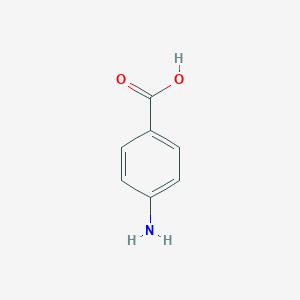| General Information of MET (ID: META00419) |
| Name |
p-Aminobenzoic acid
|
| Synonyms |
Click to Show/Hide Synonyms of This Metabolite
1-Amino-4-carboxybenzene; 4 Aminobenzoic acid, potassium salt; 4-Amino-benzoate; 4-Amino-benzoic acid; 4-Aminobenzoate; 4-Aminobenzoate, potassium; 4-Aminobenzoesaeure; 4-Aminobenzoic acid; 4-Aminobenzoic acid, potassium salt; 4-Carboxyaniline; 4-Carboxyphenylamine; ABEE; Acido p-aminobenzoico; Acidum paraminobenzoicum; Actipol; Amben; Aminobenzoate; Aminobenzoate, potassium; Aminobenzoic acid; Aniline-4-carboxylate; Aniline-4-carboxylic acid; Anti-chromotrichia factor; Anticanitic vitamin; Anticantic vitamin; Antichromotrichia factor; Bacterial vitamin H1; Chromotrichia factor; Epit vit; Epitelplast; Glenwood brand OF potassium aminobezoate; Hachemina; Jumer brand OF aminobenzoic acid; Kyselina p-aminobenzoova; Llorens brand OF aminobenzoic acid; Llorens brand OF aminobenzoic acid sodium salt; Magnesium para-aminobenzoate; Medea brand OF aminobenzoic acid; PAB; PABA; Pabacyd; Pabafilm; Pabagel; Pabamine; Pabanol; Pabasan; Papacidum; Para aminobenzoic acid; Para-aminobenzoate; Para-aminobenzoate, magnesium; Para-aminobenzoic acid; Paraminan; Paraminol; Paranate; Potaba; Potassium 4 aminobenzoate; Potassium 4-aminobenzoate; Potassium aminobenzoate; RVPaba lipstick; Romavit; Rvpaba; Sunbrella; Super shade by coppertone; Trichochromogenic factor; Trochromogenic factor; Vitamin BX', Vitamin h', '4 Aminobenzoic acid; g-Aminobenzoate; g-Aminobenzoic acid; gamma-Aminobenzoic acid; p Aminobenzoic acid; p-Amino-benzoate; p-Amino-benzoic acid; p-Aminobenzoate; p-Aminobenzoesaeure; p-Aminobenzoic acid; p-Carboxyaniline; p-Carboxyphenylamine
|
| Source |
Endogenous;Escherichia Coli Metabolite;Yeast Metabolite;Food;Drug;Cosmetic;Food additives;TCM Ingredients;Microbial
|
| Structure Type |
Benzoic acids and derivatives (Click to Show/Hide the Complete Structure Type Hierarchy)
Benzenoids
Benzene and substituted derivatives
Benzoic acids and derivatives
|
| PubChem CID |
|
| HMDB ID |
|
| Formula |
C7H7NO2
|
| Structure |
<iframe style="width: 300px; height: 300px;" frameborder="0" src="https://embed.molview.org/v1/?mode=balls&cid=978"></iframe>
|
 |
|
3D MOL
|
2D MOL
|
|
Click to Show/Hide the Molecular/Functional Data (External Links/Property/Function) of This Metabolite
|
| KEGG ID |
|
| DrugBank ID |
|
| ChEBI ID |
|
| FooDB ID |
|
| ChemSpider ID |
|
| METLIN ID |
|
| Physicochemical Properties |
Molecular Weight |
137.14 |
Topological Polar Surface Area |
63.3 |
| XlogP |
0.8 |
Complexity |
128 |
| Heavy Atom Count |
10 |
Rotatable Bond Count |
1 |
| Hydrogen Bond Donor Count |
2 |
Hydrogen Bond Acceptor Count |
3 |
| Function |
p-Aminobenzoic acid, also known as 4-aminobenzoic acid or PABA, is an organic compound with molecular formula C7H7NO2. PABA is a white crystalline substance that is only slightly soluble in water. It consists of a benzene ring substituted with an amino group and a carboxylic acid. PABA is an essential nutrient for some bacteria and is sometimes called vitamin Bx. However, PABA is not essential for humans and it varies in its activity from other B vitamins. PABA is sometimes marketed as an essential nutrient under the premise that it can stimulate intestinal bacteria. Certain bacteria in the human intestinal tract such as E. coli generate PABA from chorismate. Humans lack the enzymes to convert PABA into folate, and therefore require folate from dietary sources such as green leafy vegetables. Although some intestinal bacteria can synthesize folate from PABA and some E. coli can synthesize folate this requires six enzymatic activities in folate synthesis which are not all done in the same bacteria. PABA used to be a common sunscreen agent until it was found to also be a sensitizer. The potassium salt of PABA is used therapeutically in fibrotic skin disorders. PABA can also be found in Acetobacter (DOI: 10.3181/00379727-52-14147).
|
|
Regulatory Network
|
|
|
|
|
|
|
|
|
 click to show the details of this protein
click to show the details of this protein
 click to show the details of experiment for validating this pair
click to show the details of experiment for validating this pair
 click to show the details of this protein
click to show the details of this protein
 click to show the details of experiment for validating this pair
click to show the details of experiment for validating this pair

